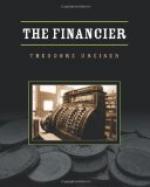Here the family began to entertain in a small way, and there came to see them, now and then, representatives of the various interests that Henry Cowperwood had encountered in his upward climb to the position of cashier. It was not a very distinguished company, but it included a number of people who were about as successful as himself—heads of small businesses who traded at his bank, dealers in dry-goods, leather, groceries (wholesale), and grain. The children had come to have intimacies of their own. Now and then, because of church connections, Mrs. Cowperwood ventured to have an afternoon tea or reception, at which even Cowperwood attempted the gallant in so far as to stand about in a genially foolish way and greet those whom his wife had invited. And so long as he could maintain his gravity very solemnly and greet people without being required to say much, it was not too painful for him. Singing was indulged in at times, a little dancing on occasion, and there was considerably more “company to dinner,” informally, than there had been previously.
And here it was, during the first year of the new life in this house, that Frank met a certain Mrs. Semple, who interested him greatly. Her husband had a pretentious shoe store on Chestnut Street, near Third, and was planning to open a second one farther out on the same street.
The occasion of the meeting was an evening call on the part of the Semples, Mr. Semple being desirous of talking with Henry Cowperwood concerning a new transportation feature which was then entering the world—namely, street-cars. A tentative line, incorporated by the North Pennsylvania Railway Company, had been put into operation on a mile and a half of tracks extending from Willow Street along Front to Germantown Road, and thence by various streets to what was then known as the Cohocksink Depot; and it was thought that in time this mode of locomotion might drive out the hundreds of omnibuses which now crowded and made impassable the downtown streets. Young Cowperwood had been greatly interested from the start. Railway transportation, as a whole, interested him, anyway, but this particular phase was most fascinating. It was already creating widespread discussion, and he, with others, had gone to see it. A strange but interesting new type of car, fourteen feet long, seven feet wide, and nearly the same height, running on small iron car-wheels, was giving great satisfaction as being quieter and easier-riding than omnibuses; and Alfred Semple was privately considering investing in another proposed line which, if it could secure a franchise from the legislature, was to run on Fifth and Sixth streets.
Cowperwood, Senior, saw a great future for this thing; but he did not see as yet how the capital was to be raised for it. Frank believed that Tighe & Co. should attempt to become the selling agents of this new stock of the Fifth and Sixth Street Company in the event it succeeded in getting a franchise. He understood that a company was already formed, that a large amount of stock was to be issued against the prospective franchise, and that these shares were to be sold at five dollars, as against an ultimate par value of one hundred. He wished he had sufficient money to take a large block of them.




